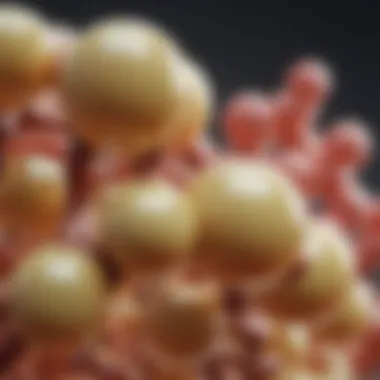Vitamin E's Impact on Vaginal Health and Wellness


Intro
Vitamin E is a fat-soluble vitamin that plays a significant role in numerous biological processes. As an antioxidant, it contributes to cellular health by protecting against oxidative stress. Interestingly, recent studies have unearthed its potential importance in promoting vaginal health. This aspect has become increasingly relevant for a population seeking natural, effective solutions to common feminine health concerns. Understanding the implications of vitamin E in this context is essential, particularly in addressing issues like dryness, irritation, and overall vaginal integrity.
Research Context
Background Information
Vaginal health is influenced by several factors, including hormonal fluctuations, lifestyle choices, and diet. For women, maintaining this health is pivotal for comfort and sexual well-being. Vitamin E is gaining interest due to its unique properties. It permeates cellular structures, fostering moisture retention and soothing inflammation. Comprehensive research has begun to shed light on how this vitamin can fortify the vaginal mucosa, making it an appealing avenue for those seeking preventive or therapeutic measures.
Importance of the Study
The study of vitamin E in relation to vaginal health is not merely an academic exercise. It holds potential implications for personal care practices. As the awareness of natural alternatives increases among consumers, understanding the efficacy of vitamin E can empower individuals to improve their health without relying solely on pharmaceuticals. Moreover, this research catalyzes a broader conversation about women's health products, emphasizing the need for evidence-based solutions in a market often saturated with unverified claims.
Discussion
Interpretation of Results
Current evidence suggests that vitamin E could enhance moisture levels in the vaginal tissues. Increased moisture can reduce discomfort associated with dryness, a common issue faced by many women, particularly during and after menopause. Furthermore, by mitigating inflammation, vitamin E can alleviate symptoms related to infections or irritations. This multifaceted approach makes it a valuable addition to many personal care regimens.
Comparison with Previous Research
Historically, research on feminine health predominantly focused on hormonal therapies or prescription treatments. However, findings surrounding vitamin E resonate with the growing trend toward holistic approaches. Previous studies indicated the benefits of various natural remedies; however, few pinpointed vitamin E's specific contributions to vaginal health. The shift towards investigating nutrients in preventative health strategies marks a progressive step in women's health research.
Vitamin E represents a promising avenue for enhancing vaginal health, addressing concerns that affect many women in silence.
The End
The exploration of vitamin E in maintaining vaginal health highlights the need for consumer awareness and informed choices. It encourages a shift towards holistic health practices, emphasizing the role of nutrients in preventing common ailments. As research continues to evolve, the dialogue surrounding natural health solutions will undoubtedly expand.
Preamble to Vitamin E
Vitamin E plays a notable role in human health, functioning primarily as a potent antioxidant. This nutrient is completely essential for maintaining various bodily processes and has been increasingly scrutinized for its benefits in specific areas, such as vaginal health. Understanding vitamin E’s characteristics lays the groundwork for exploring its relevance in maintaining vaginal integrity and addressing common health issues.
In the context of vaginal health, vitamin E's antioxidant properties help protect cells from oxidative stress. Oxidative stress can lead to tissue damage and inflammation, both of which can affect the health of the vaginal region. This is particularly significant for women experiencing hormonal changes during menopause or those susceptible to infections.
Additionally, vitamin E aids in moisture retention, which is crucial for preserving the vaginal epithelium's function and comfort. This nutrient's ability to enhance tissue resilience makes it a key player not only in prevention but also in treatment strategies for various conditions.
Chemical Structure and Function
Vitamin E comprises a group of fat-soluble compounds that include tocopherols and tocotrienols. The most common and researched form is alpha-tocopherol. Its chemical structure allows it to integrate easily into cell membranes and neutralize free radicals effectively. This action reduces cellular damage, thereby maintaining the overall health of tissue.
The antioxidant function of vitamin E is particularly important in vaginal tissues, which are sensitive and can be prone to irritation or infection. Proper cellular function in the vaginal area relies on antioxidant defense, which is where vitamin E becomes critical. Its preservation of cellular integrity also means it can play a role in the healing processes of damaged tissues.
Sources of Vitamin E
Vitamin E can be obtained through various dietary sources, which should be integrated into one’s regular nutrition for optimal health. Common sources include:
- Nuts and seeds: Almonds and sunflower seeds are rich in vitamin E.
- Vegetable oils: Wheat germ oil, sunflower oil, and safflower oil are significant contributors.
- Leafy greens: Spinach and kale also provide substantial amounts of this vital nutrient.
- Fortified foods: Some cereals and juices have vitamin E added to enhance nutrition.
Incorporating these foods into daily meals may not only support vaginal health but also overall well-being. Adequate intake contributes to a balanced diet, crucial for maintaining various bodily functions, including hormonal balance, necessary for vaginal health.
Important Note: Consulting with a healthcare professional regarding dietary recommendations and potential supplementation can provide targeted strategies for health needs.
Understanding Vaginal Health
Vaginal health is crucial for overall female well-being. It encompasses multiple aspects that influence a person's comfort and quality of life. Understanding how to maintain vaginal health is vital not only for physical comfort but also for emotional well-being. The vaginal ecosystem is complex, characterized by a balance of microorganisms. This balance is essential to protect against infections and maintain moisture.


Maintaining vaginal health involves a combination of lifestyle choices, awareness of bodily changes, and regular medical check-ups. Factors like diet, hygiene practices, and hormonal fluctuations significantly impact this balance, making it essential to grasp these concepts deeply. Additionally, understanding how to recognize symptoms of abnormalities can lead to timely intervention, which is often crucial.
Key Concepts of Vaginal Flora
Vaginal flora refers to the community of microorganisms residing in the vagina. This microbial community consists primarily of various bacteria, with Lactobacillus species being dominant. These bacteria play a protective role by helping to maintain an acidic environment, which is hostile to harmful pathogens.
A healthy vaginal flora contributes to:
- Infection Resistance: The balance of good bacteria helps prevent conditions like bacterial vaginosis and yeast infections.
- pH Balance: A normal vaginal pH level (typically between 3.8 and 4.5) is vital for maintaining flora balance.
- Mucosal Integrity: Healthy flora contributes to the integrity of the vaginal lining, promoting comfort and sexual health.
An imbalance in this flora can lead to issues. Recognizing the signs of imbalance, such as unusual discharge or irritation, is crucial for timely management.
Common Vaginal Issues
Despite the body’s natural defenses, women might experience several common vaginal issues. These can include:
- Vaginal Infections: Conditions such as yeast infections or bacterial vaginosis manifest through symptoms like unusual discharge, itching, or odor.
- Dryness: Hormonal changes, particularly during menopause, can lead to vaginal dryness, causing discomfort and impacting sexual health.
- Irritation and Inflammation: Skin irritation can arise from various factors like hygiene products, soaps, or fabrics that are irritating to sensitive skin. This can lead to further discomfort and issues.
Being proactive in understanding these issues is essential for effective management. Lifestyle changes, proper hygiene, and open communication with healthcare providers can significantly mitigate these concerns.
Role of Vitamin E in Vaginal Health
Vitamin E plays a significant role in maintaining vaginal health. It is essential to recognize how this nutrient can contribute to various aspects of vaginal well-being. Many women experience challenges related to moisture levels, infections, and inflammation within the vaginal area. Vitamin E serves as a multifaceted solution to these issues by providing key benefits.
Antioxidant Properties
The antioxidant properties of vitamin E are critical in safeguarding vaginal health. The vaginal environment is susceptible to oxidative stress due to various factors like infections, hormonal changes, and age. Vitamin E helps neutralize free radicals, which can damage cells and lead to health complications. This antioxidant activity is thought to promote healthier cellular function and enhance overall wellbeing.
"Through its antioxidant properties, vitamin E protects cells from oxidative damage, thus supporting tissue vitality."
Research indicates that adequate vitamin E levels may improve the resilience of vaginal tissues, helping to prevent issues such as unwanted infections. Furthermore, its ability to combat free radicals aids in maintaining a natural balance within the vaginal flora.
Moisture Retention
Another essential aspect of vitamin E is its role in moisture retention. Many women suffer from dryness in the vaginal area, which can lead to discomfort and an increased risk of infections. Vitamin E contributes to moisture retention by enhancing the skin barrier function. This process helps maintain hydration levels, making it easier to stay comfortable.
Studies show that vitamin E oil can be applied topically to manage dryness and improve comfort during intimate activities. The lipid-soluble nature of vitamin E allows it to penetrate the skin effectively. Hence, it aids in achieving lasting hydration in sensitive areas.
Anti-inflammatory Effects
Vitamin E's anti-inflammatory properties are equally important when considering vaginal health. Inflammation can lead to a range of issues, such as irritation, discomfort, and even infections. This nutrient can help soothe inflammation and reduce associated symptoms. Notably, vitamin E works by modulating the immune response, leading to decreased inflammation in the vaginal area.
Literature supports the view that vitamin E supplementation may be beneficial for those suffering from inflammatory conditions. By incorporating vitamin E, women may experience relief from discomfort, making it a valuable ally in achieving better overall vaginal health.
Topical Applications of Vitamin E
The application of vitamin E directly to the skin can play a significant role in promoting vaginal health. Topical applications are valuable because they allow for direct contact with the area needing support, which can enhance the nutrient's effectiveness. When applied locally, vitamin E can target specific issues such as dryness or irritation, making it a sought-after choice for various personal care solutions. In this section, we will look at different forms of topical applications, preparation methods, and the benefits of regular use.
Forms of Topical Applications
Several forms of topical applications are available for vitamin E. These forms can cater to diverse needs and preferences. Common options include:
- Oils: Vitamin E oil is a concentrated version of the nutrient. It can be used alone or mixed with other oils, such as coconut oil, for enhanced moisturizing.
- Creams and Lotions: These often combine vitamin E with other beneficial ingredients for skin health and are designed for ease of use. They can be applied as a part of a daily routine.
- Suppositories: Some products are designed specifically for vaginal use. Vitamin E suppositories can directly address issues within the intimate area, aiding in moisture and discomfort relief.
- Capsules: These can be opened and applied as oil directly to the skin, providing a convenient option for targeted application.
Each form has unique benefits and applications. It is essential to choose the one that fits individual needs.
Preparation Methods
When utilizing vitamin E in topical applications, preparation methods can vary. It is crucial to follow appropriate steps to ensure safety and effectiveness. Common preparation methods include:


- Direct Application: For oils, simply apply a few drops to the affected area. This is simple but effective.
- Mixing with Other Ingredients: For creams or lotions, you may combine vitamin E oil with other moisturizing agents. For instance, mixing with aloe vera gel can humidify the skin further.
- Creating Suppositories: When making vitamin E suppositories, it is essential to follow precise guidelines. Melt vitamin E capsules in a double boiler, and once liquefied, pour into molds to cool and solidify before use.
- Oil Infusion: Infusing vitamin E with other herbs or oils can provide a broader spectrum of benefits. The infusion method generally requires simmering oil with herbs for several hours.
These methods allow for versatility and adaptability in utilizing vitamin E effectively.
Benefits of Regular Use
Incorporating vitamin E topically into a daily regimen can yield numerous benefits:
- Enhanced Moisture: Regular use helps maintain hydration levels in the vaginal area, reducing dryness and discomfort.
- Skin Health: Vitamin E is known to nourish the skin, promoting its elasticity and general health.
- Anti-inflammatory Effects: It can help soothe inflammation, making it useful for individuals experiencing irritation.
- Healing Support: The nutrient supports healing in minor abrasions or irritation, promoting overall vaginal integrity.
- Antioxidant Protection: By protecting cells from damage, vitamin E creates a healthier environment for vaginal flora, essential for maintaining balance.
Regular incorporation of vitamin E in topical applications is a practical choice, enhancing vaginal health and well-being.
Vitamin E Supplements and Dosing
Vitamin E supplements are an important aspect of managing vaginal health. They can offer various benefits that can enhance overall well-being. Notably, vitamin E acts as a powerful antioxidant, which can help reduce oxidative stress in the body. This aspect is critically relevant as oxidative stress has been linked to numerous health issues, including problems with vaginal integrity.
Oral supplements may be a significant way to boost the intake of vitamin E for those who do not get sufficient amounts from their diet. They come in various forms, including natural and synthetic options. The addition of vitamin E supplements can be particularly beneficial for individuals experiencing dryness or inflammation in the vaginal area, as consistent intake may aid in alleviating these symptoms. Importantly, understanding the right dosage is essential to avoid any potential side effects or risks associated with overuse.
Oral Supplements
Oral vitamin E supplements are widely available and can provide an effective means to increase vitamin levels in the body. Various formulations exist, including soft gels, tablets, and capsules. Individuals can choose from natural sources or synthetic options. Natural vitamin E, which is derived from vegetable oils, tends to be more bioavailable, meaning that the body can easily absorb it. On the other hand, some synthetic forms may be less effective in providing benefits.
When selecting a vitamin E supplement, one should consider:
- Quality of the product: Look for reputable brands that guarantee potency and purity.
- Type of vitamin E: Natural forms, such as d-alpha-tocopherol, are often recommended over synthetic forms, which may not offer the same level of health benefits.
- Additional ingredients: Some supplements may contain other vitamins or minerals that can be helpful in promoting vaginal health.
Recommended Dosage
Determining the right dosage of vitamin E varies based on individual needs and health conditions. The Recommended Dietary Allowance (RDA) for vitamin E is based on the amount required to prevent deficiency. Generally, adults are advised to aim for around 15 mg (or 22.4 IU) per day. However, certain conditions, like hormonal imbalances or specific vaginal health issues, may necessitate higher doses. It is crucial to consult with a healthcare provider before commencing supplementation. They can provide a tailored approach that considers individual health profiles.
Some key takeaway points regarding vitamin E dosages include:
- Start with a lower dosage to assess tolerance and effectiveness.
- Avoid excessive intake, which can lead to risks such as bleeding problems, particularly in individuals taking anticoagulant medications.
- Monitor symptoms: Track any changes in vaginal health or side effects, and adjust the dosage under professional guidance.
Vitamin E supplementation can be a valuable tool, but personalized advice from healthcare specialists can ensure safe and effective use.
Safety and Side Effects
When it comes to health supplements and topical applications, discussions around safety and side effects are crucial. Understanding the potential risks associated with Vitamin E is essential for anyone considering its use, particularly in relation to vaginal health. This section aims to provide an informative look at the possible adverse effects of Vitamin E, emphasizing both the importance of moderation and awareness of individual sensitivities.
Potential Risks of Overuse
Vitamin E is generally considered safe when used within recommended guidelines. However, overuse can lead to several complications. Excessive intake of Vitamin E, especially through oral supplements, may increase the risk of adverse effects. One primary concern is the potential for heightened bleeding tendency, as Vitamin E can interfere with blood clotting. Individuals on anticoagulant medication should exercise caution and consult a healthcare provider before increasing their Vitamin E intake.
Moreover, using high concentrations of Vitamin E in topical applications may result in irritation or an imbalance in vaginal flora. It is vital to adhere to guidelines provided by manufacturers or health professionals to minimize such risks. Some users may experience gastrointestinal issues from high doses, such as nausea and diarrhea. Striking a balance in dosage is important to optimize benefits while reducing possible adverse outcomes.
Allergic Reactions
Allergic reactions to Vitamin E, while relatively rare, are still a concern. Symptoms may include red, itchy skin, rashes, or swelling in the area of application. An allergic reaction is not always immediate; some may experience delayed reactions after repeated use.
To avoid these instances, conducting a patch test on a small area of skin before large applications is beneficial. If any signs of an allergic response occur, immediate cessation of use is recommended. Individuals with known allergies to soy or nuts should also take caution, as many Vitamin E supplements are derived from these sources. Always read the labels carefully to ensure safety.
It is essential to be vigilant about product ingredients and any known allergies.
Taking these precautions can help in reducing the likelihood of adverse reactions. In summary, while Vitamin E can contribute positively to vaginal health, awareness of potential risks and the need for moderation cannot be overstated. Always consult healthcare providers when in doubt, especially when considering changes to health routines.
Research Insights on Vitamin E and Vaginal Health


In recent years, the connection between vitamin E and vaginal health has been increasingly explored in scientific literature. This area of research is vital, as it outlines how this essential nutrient contributes to various aspects of vaginal wellbeing. The insights gained from these studies shed light on the mechanisms by which vitamin E operates, its efficacy in treating vaginal issues, and the overall benefits it offers to individuals seeking to enhance their intimate health. Understanding these insights can help healthcare professionals and individuals make informed decisions regarding the incorporation of vitamin E into their regimens.
Key Studies and Their Findings
Several key studies reveal significant findings regarding the role of vitamin E in vaginal health. One notable study published in the Journal of Obstetrics and Gynaecology found that topical application of vitamin E improved vaginal moisture in women experiencing dryness. The participants reported greater comfort levels during intercourse, indicating the nutrient's positive effect on vaginal integrity.
Another important research conducted by researchers at the University of California highlighted that vitamin E’s antioxidant properties play a crucial role in reducing oxidative stress in vaginal tissues. This reduction can help combat inflammation and promote healthier cells, thereby addressing symptoms related to conditions like vulvovaginal atrophy and infections.
Additionally, an interesting randomized controlled trial assessed the effectiveness of vitamin E in conjunction with other therapies to relieve vaginal atrophy in postmenopausal women. The results indicated that those who received vitamin E supplements reported significantly improved symptoms compared to the placebo group, strengthening the argument for its inclusion in therapeutic strategies.
"Vitamin E not only improves moisture and comfort but also acts as an important antioxidant agent improving overall vaginal health," researchers stated in their evaluation.
Gaps in Current Research
Despite the progress made in understanding vitamin E's benefits, some gaps exist within current research. For one, many studies primarily focus on female populations, leaving out insights on how vitamin E may affect those who identify as male or non-binary. This presents a significant gap as the diverse spectrum of gender identity can also experience unique vaginal health concerns.
Moreover, while some studies have explored dosage and effectiveness, there is still a lack of consensus regarding the optimal forms and dosages of vitamin E for various conditions. Most research tends to concentrate on topical applications and oral supplements, but comparatively less is known about long-term effects or doses specifically tailored for vulnerable populations, like pregnant women or those with underlying health issues.
Finally, there is a need for more comprehensive longitudinal studies that examine the long-term effects of vitamin E in relation to vaginal health. Such studies would provide clearer insights into the safety of prolonged use and possible cumulative effects or interactions with other treatments.
Overall, while current research points to numerous advantages of vitamin E, a deeper exploration of these gaps could unveil more tailored approaches to incorporate this nutrient into broader health strategies.
Practical Tips for Incorporating Vitamin E
Incorporating Vitamin E into your routine is essential for enhancing vaginal health. Knowledge about effective methods to use this nutrient can empower individuals to take charge of their well-being. Understanding how to integrate Vitamin E in daily life can yield significant benefits across various aspects of vaginal health.
Dietary Sources to Consider
Diet plays a crucial role in maintaining adequate levels of Vitamin E. Including foods rich in this vitamin can provide essential benefits.
Here are some dietary sources worth considering:
- Nuts and Seeds: Almonds, sunflower seeds, and hazelnuts are excellent sources. A handful of almonds can provide a substantial amount.
- Vegetable Oils: Sunflower oil, safflower oil, and olive oil contain significant Vitamin E content. Using these oils in cooking can enhance dietary intake.
- Leafy Greens: Spinach and kale not only provide fiber but are also packed with Vitamin E.
- Fruits: Mangoes and avocados are tasty options that can fit well in most diets.
Reviewing dietary habits can help identify gaps in Vitamin E consumption. Adjusting daily meals to include these sources can noticeably improve vaginal health.
Choosing Quality Products
Not all Vitamin E products are equal. Evaluating quality is key when selecting products intended for personal care. Consider these factors to ensure effective use:
- Form of Vitamin E: Look for products that contain "d-alpha-tocopherol," which is the natural form and more bioavailable compared to synthetic forms.
- Purity and Additives: Always check the label for potential additives or fillers. Products should ideally be free from parabens and fragrances that can irritate sensitive areas.
- Reputation of Manufacturer: Opt for well-known brands with positive user reviews and proven efficacy. Researching the manufacturer’s credibility ensures you choose trustworthy options.
- Certifications: Products with organic or clinically tested certifications can be indicative of higher quality.
Epilogue
In this article, we examined the significant role of Vitamin E in vaginal health. This nutrient is not just important for general health; its specific benefits for vaginal integrity, moisture, and inflammation relief cannot be understated. Understanding how Vitamin E functions at a biochemical level reveals why it is often recommended for individuals experiencing various vaginal health issues. Notably, its antioxidant properties help combat oxidative stress, which can damage cellular structures.
Vitamin E also plays a crucial role in maintaining proper moisture levels, which is vital for comfort and overall wellbeing. Individuals suffering from dryness may find that applying Vitamin E can alleviate discomfort and improve quality of life. Moreover, its anti-inflammatory properties can contribute to reducing irritation and potential infections, making it a valuable addition to personal care routines.
In summary, not only does Vitamin E support the physical aspects of vaginal health, but its incorporation into daily routines can lead to improved emotional wellbeing as well. By providing insights into practical applications, dietary sources, and supplementation, this article aims to empower readers with actionable knowledge.
"Integrating Vitamin E into personal care regimens could be a simple yet effective strategy for improving vaginal health."
The information presented also highlights the necessity for further research. As studies continue to emerge, they will shed more light on the multifaceted benefits of Vitamin E.
Summary of Key Points
- Vitamin E is crucial for maintaining vaginal health due to its antioxidant, moisturizing, and anti-inflammatory properties.
- Topical applications and dietary sources can effectively deliver Vitamin E to the body.
- Understanding the significance of moisture retention and inflammation relief enhances the overall quality of life for many individuals.
- Future research is needed to fully explore the potential of Vitamin E in clinical applications related to vaginal health.
Future Directions for Research
The current body of research on Vitamin E and vaginal health, while promising, has gaps that need to be addressed. Future studies could focus on:
- Longitudinal Studies: Exploring long-term effects of Vitamin E supplementation on vaginal health.
- Diversity in Population: Including a broader demographic in clinical trials to see how different genetic backgrounds respond.
- Combination Therapies: Investigating the effects of Vitamin E in conjunction with other treatments for vaginal issues.
- Mechanistic Studies: Delving deeper into the biochemical pathways through which Vitamin E exerts its effects.
As our understanding of Vitamin E grows, so does the potential for better health outcomes in the area of vaginal wellbeing. Engaging with this subject encourages a proactive approach to women's health, inviting both researchers and patients to explore the implications and applications of Vitamin E.















